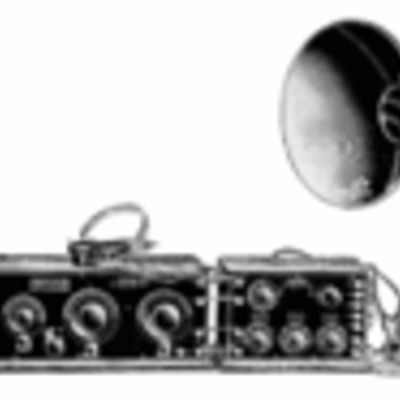Early 1920s radio and horn speaker
Dublin Core
Title
Early 1920s radio and horn speaker
Subject
Radio receivers before 1922
Description
A drawing of an early vacuum tube regenerative radio receiver and horn loudspeaker, the Paragon receiver, made by Adams-Morgan Co., Montclair, New Jersey, USA, from an advertisement in a radio magazine around 1922. The radio consists of two units; the single tube RD-5 regenerative receiver (left) and the two tube A-2 audio amplifier (right) to drive the Magnavox speaker. Before broadcasting began around 1920, radio listening was a solitary hobby, so most radios didn't produce enough power to drive speakers and earphones (on top of set) were used, so only one person could listen at a time. After broadcasting began, manufacturers began adding amplifier units and loudspeakers to their radios to cater to the desire of families to listen to radio together. Vacuum tubes had low power output, so horn speakers were required to get enough volume to fill a room; a disadvantage of this was horns cut off bass frequencies so they sounded "tinny". Most radios of this vintage ran off batteries; this one came with a 22V "B" battery for plate supply and a 6V rechargeable lead-acid battery for filament current.
Creator
Charles William Taussig
Source
Retrieved February 13, 2013 from Charles William Taussig, James C. Edgerton (1922) The Book of Radio, D. Appleton and Co., p. 146, fig. 135 on Google Books
Publisher
Chetvorno
Date
13 January 2014
Rights
Public Domain
Format
JPEG
Language
English
Type
drawing
Still Image Item Type Metadata
Original Format
drawing
Physical Dimensions
1,159 × 845 (155 KB)
Citation
Charles William Taussig
, “Early 1920s radio and horn speaker,” History 502 Spring 2018 Omeka, accessed May 19, 2024, https://csusmhistorydepartment.com/H502/S18/OMEKA/items/show/141.
